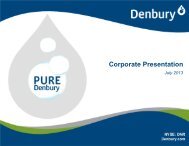Interactive 2009 Annual Report (PDF 7.56 MB) - Denbury Resources ...
Interactive 2009 Annual Report (PDF 7.56 MB) - Denbury Resources ...
Interactive 2009 Annual Report (PDF 7.56 MB) - Denbury Resources ...
- No tags were found...
Create successful ePaper yourself
Turn your PDF publications into a flip-book with our unique Google optimized e-Paper software.
<strong>Denbury</strong> <strong>Resources</strong> Inc. <strong>2009</strong> <strong>Annual</strong> <strong>Report</strong> 51Oil production from our tertiary operations increased to an average of 24,343 Bbls/d during <strong>2009</strong>, a 26% increaseover our 2008 tertiary production level of 19,377 Bbls/d. Tertiary oil production during the fourth quarter of <strong>2009</strong>averaged 26,307 Bbls/d, a 20% increase over the fourth quarter 2008 levels, and an 8% sequential increase from thirdquarter <strong>2009</strong> levels. These year-over-year increases are the result of production growth in response to continuedexpansion of the tertiary floods in our Tinsley, Soso, Eucutta and Brookhaven Fields, and to initial production responsefrom Cranfield and Heidelberg Fields. We had our first production response from Cranfield Field during the first quarterof <strong>2009</strong> and our first response from Heidelberg Field in the second quarter of <strong>2009</strong>, a little earlier than anticipated.Tinsley field has been one of our top performing tertiary oil fields, and production there is expected to increase as wecontinue to expand the flood. The declines at Mallalieu Field during the second and third quarters of <strong>2009</strong> were partiallydue to CO 2 recycle volumes exceeding the plant capacity, which limited production volumes. We have expanded thecapacity of the facility, which expansion capacity became operational early in the fourth quarter of <strong>2009</strong>. Although wereceived an initial increase in production following completion of the facility, we anticipate that production at MallalieuField will begin to decline again in the near future. The Delhi pipeline is complete, and we initiated CO 2 injections atDelhi Field (Phase 5) during November <strong>2009</strong>. We currently anticipate tertiary production response at Delhi Field aroundmid-year 2010.During <strong>2009</strong>, operating costs for our tertiary properties averaged $21.67 per Bbl, lower than the prior year’s averageof $23.57 per Bbl. During the fourth quarter of <strong>2009</strong>, the operating costs on our tertiary properties averaged $22.03 perBbl as compared to $21.86 per Bbl in the fourth quarter of 2008 and $23.14 per Bbl during the third quarter of <strong>2009</strong>.Our per barrel costs in <strong>2009</strong> are lower than in 2008 due primarily to the reduced cost of CO 2 in the current year period.On a per barrel basis, our cost of CO 2 decreased by $1.99 per Bbl, from $5.95 per Bbl in 2008 to $3.96 per Bbl in<strong>2009</strong>, primarily due to the reduction in oil prices to which our CO 2 costs are partially tied. Our single highest cost forour tertiary operations is our cost for fuel and utilities, which averaged $5.76 per Bbl in <strong>2009</strong>, $5.39 per Bbl in 2008 and$4.71 per Bbl in 2007, which has increased on a per barrel basis due to continued expansion of our tertiary floods. Forany specific field, we expect our tertiary lease operating expense per BOE to be high initially, then decrease asproduction increases, ultimately leveling off until production begins to decline in the latter life of the field, when leaseoperating expense per BOE will again increase.Through December 31, <strong>2009</strong>, we have invested a total of $1.8 billion in tertiary fields (including allocated acquisitioncosts and amounts assigned to Goodwill) and have only $225.7 million in unrecovered net cash flow (revenue lessoperating expenses and capital expenditures). Of this total invested amount, approximately $487.4 million (27%) wasspent on fields which have yet to have appreciable proved reserves at December 31, <strong>2009</strong> (i.e., fields for whichsignificant incremental proved reserves are anticipated during 2010 and beyond). The proved oil reserves in our CO 2fields have a PV-10 Value of $2.3 billion, using the calendar <strong>2009</strong> first-day-of-the-month 12-month unweightedaverage NYMEX pricing of $61.18 per Bbl. These amounts do not include the capital costs or related depreciationand amortization of our CO 2 producing properties, but do include CO 2 source field lease operating costs andtransportation costs.CO 2 Source Field and Tertiary Oil Field Related Capital Budget for 2010. Our current capital spending plans for2010 include approximately $74 million to be spent in the Jackson Dome area with the intent to add CO 2 reserves anddeliverability for future operations, approximately $365 million to be spent in development of our tertiary floods, andapproximately $159 million to be spent for our CO 2 pipelines, making our combined CO 2 related expenditures over 90%of our $650 million 2010 capital budget.Operating ResultsAs summarized in the “Overview” section above, and discussed in further detail below, our operating resultsincreased from 2007 to 2008, but decreased from 2008 to <strong>2009</strong>. The primary factors impacting our operating resultswere fluctuating commodity prices, changes in the fair value of our oil and natural gas derivative contracts, andincreases and decreases in production, which are all explained in more detail below.Management’s Discussion and Analysis of Financial Condition and Results of OperationsForm 10-K Part II




